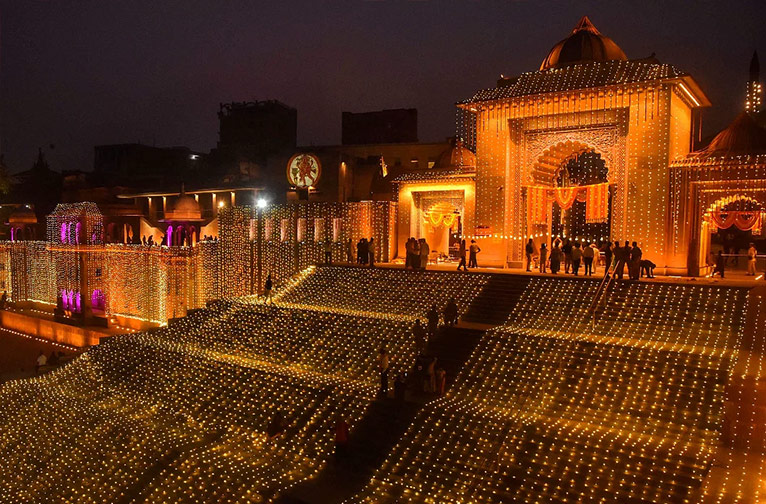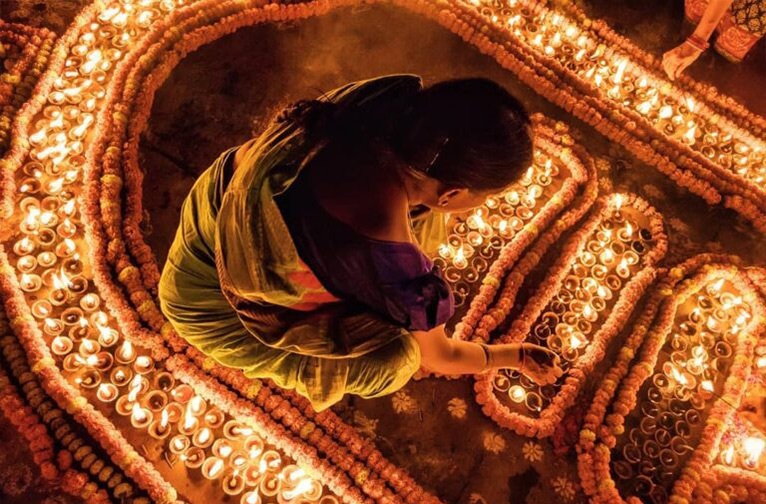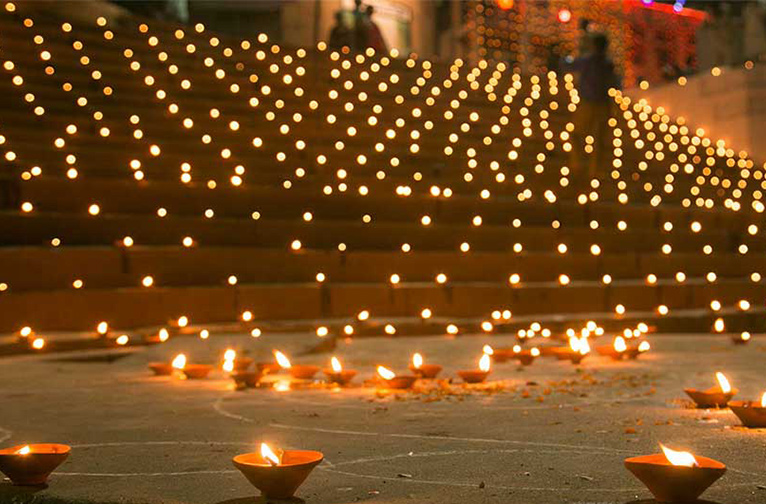The citizenry of Varanasi, one of the oldest continuously inhabited cities in the world, feels doubly blessed celebrating the onset of the Hindu New Year with Diwali. But this pan-India ‘Festival of Lights’, in the Kashi of yesteryears, holds even more special significance as it gets to celebrate it twice over with the gods themselves on Dev Diwali.
The word ‘Kashi’ itself means ‘luminous’ or the ‘tower of light’ and is thus eternally intertwined with the Hindu myth of the transformation of the earth from darkness and chaos to light and enlightenment.
Varanasi’s connection with the celestial world is a deep and potent one. The Festival of Lights is of particular importance as the city itself is known as the “City of Light”. According to Hindu mythology it is from here that Lord Shiva, emerging from the cosmic waters, first beamed out the ray of celestial light to pierce the primordial darkness that enshrouded Earth before the dawn of creation.
The ultimate Hindu pilgrimage point, Varanasi is revered as the earthly home of Lord Shiva. It is the bridge between heaven and earth. Practicing Hindus long to end their days on Earth in the hallowed waters of the Ganga at Varanasi as Shiva represents the eternal cycle of life and the journey from darkness to light. For them the old adage “Kashivam maranam moksha”, death in Kashi is the true salvation, is the primary motive for ending their days in this holy city. It is believed that Lord Shiva himself whispers in the ear of a dying person, the sacred mantra which will give him release (moksha) from the cycle of birth and rebirth— to forever merge with the Universe.


Older than legend, Varanasi is home to the beautiful Kashi Vishwanath Temple, which has been destroyed and rebuilt several times. Dedicated to Lord Shiva it is at the very core of the city’s spiritual temporal pursuits. During the Diwali celebrations the beautifully illuminated shrine is thronged by devotees who travel from all over the world from the blessings of the deity.
While Diwali is celebrated across India on the night of Amavasya or a moonless night of Kartik, Dev Diwali or the ‘festival of lights for the gods’ is celebrated on a full moon (Poornima) night in the holy month of Kartik according to the Hindu calendar. It marks the division in each month between the two lunar fortnights (paksha), and the Moon is aligned exactly in a straight line (or a syzygy) with the Sun and Earth. The full moon is considered a highly auspicious and sacred symbol in the Indian lunar calendar. Dev Diwali marks an end to the Diwali celebrations and concludes the Tulsi Vivah ritual.
Unlike the pan-India celebrations of Diwali, Dev Diwali is celebrated exclusively in Varanasi. The "Diwali of the Gods”, held 15 days after the traditional Diwali, marks the day when the gods descend from the heavens to the riverside city to bathe in the holy Ganga and celebrate Diwali with the citizens. This night is also a celestial celebration of Lord Shiva’s victory, over three demons—Vidyunmali, Tarakaksha, and Viryavana— collectively known as Tripurasura. The three-headed demon had held all three realms in a stranglehold and had terrified the people with his exploits. This event is emblematic also of the triumph of good over evil.


This auspicious occasion is marked by special rituals. In the early hours a cool dawnlit morning devotees descend in great throngs on the ghats for the traditional purification dip (Ganga snan) in the sacred river. Visiting the temples and making offerings of sweets, flowers, sweets, and incense to the gods for their blessings is a family ritual. Alms giving and feeding of the poor are said to heighten your merit in the eyes of the gods. At night thousands of lighted diyas (clay lamps) set free on the waters of the Ganga aglitter in the spirit of pure-hearted goodwill and spiritual harmony with the world. The play of laser lights adds a contemporary twist to an ancient ritual.
Varanasi shines like a stairway to heaven to facilitate the arrival of the gods. The blaze of diyas comes into play upon sighting of the full moon. The glittering façade of the riverfront is a resplendent welcome to the deities as they arrive at the sacred ghats, ablaze with lights from thousands of diyas and beautiful hand drawn floral rangolis, to take a ritual bath in the holy Ganga before participating in the explosion of celebrations in the temples and streets of the city.
The ritual of ‘deepdan’, or lighting of the diyas, marks the veneration accorded to the Goddess Ganga.
One of the most moving experiences is the elaborate Ganga aarti performed at sunset on the banks of the river; a regular feature all year round it is propelled by even more powerful energy channeled through the collective devotion of the huge gathering at the ghat during Diwali. A total of 24 Brahmin priests and 24 girls performs this age-old ritual.
Richly atmospheric, the celestial vibe of the Dasashvamedh Ghat is further heightened by the aromatic scents of sandalwood incense and camphor, the chanting of Vedic hymns by the priests, the ringing of bells, and liberating sounds of conch shells.
One of the most photogenic sites in the city, the Dasashvamedh Ghat is a painter’s dream subject. Awash with devotees, its riverside location it is constantly abustle, its resplendent vignettes a cultural delight through the day and late at night. This is the site where Lord Brahma is said to have performed his legendary ten (dash) ashwamedha (horse) sacrifices
Processions of the deities from several shrines are heightened with the illuminations of elaborate fireworks brightening the night sky. For devotees and tourists alike, it is a heart stopping experience of spiritual and cultural significance.
The light of the full moon on the holy waters of the Ganga creates an alluring silvery passage to explore the glittering city from another perspective. A boat ride on the local bajdas, which are decorated with marigold garlands, flowers, diyas and fairy lights, is highly enjoyable as you drift down the silvery river. The sights of the beautifully illuminated river front of the Heritage Zone with its collection of temples, sacred ghats and palaces on Dev Diwali is an unmissable cultural treat. Dasashvamedh Ghat, Assi Ghat, and Rajendra Prasad Ghat are especially resplendent with the blaze of diyas and strings of fairy lights.
During your wanderings around the riverside area you should also visit Manikarnika Ghat (an atmospheric hub conducting the last rites and cremations of Hindus); Manmahal Ghat (for the Jantar Mantar established by Maharaja Swai Jai Singh II of Jaipur and, the ASI museum); Lalita Ghat (for the beautiful Nepali Pashupatinath Temple), Tulsi Ghat (where poet Tulsi Das lived and wrote his famous Ramcharitmanas), amongst others. If you are an art lover do head for Prabhu Ghat, Maa Anandamayi Ghat, Reewa Ghat, and Janaki Ghat for some exceptional viewings of graffiti.
Dev Diwali also celebrates the birthday of Lord Kartikeya, the eldest son of Lord Shiva and Goddess Parvati. It is also regarded as the day Lord Vishnu entered his first incarnation— “Matsya”.’
Dev Diwali Varanasi is also marked as a day to commemorate the martyrs of the Indian armed forces, The ceremonials are held at the Dashwamedha Ghat with flowers, wreaths and lighted lamps at the Amar Jawan Jyoti.
An unmissable part of the Dev Diwali celebrations is the line-up of cultural programs, music and dance performances rooted in Indian classic traditions, the readings of the scriptures and temple visits with family and friends.
The Ganga Mohotsav, a grand 5-day festival, kicks off on the auspicious occasion of Prabodhani Ekadashi (the 11th day of the lunar month of Kartik), and culminates on Dev Diwali.
Time your visit on the cusp of Diwali to this ancient pilgrimage hub by the holy Ganga, which is also known as Varanasi, Benaras and Kashi. It’s the best time to unravel the myth and mystique of the double Diwali which is embedded in the culture of this city, which is older than time itself.